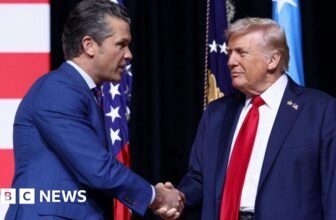Internal Struggles of the Republican Party: A Review of Current Dynamics
Introduction to the Republican Party’s Turmoil
The Republican Party, a cornerstone of American political history, is currently facing significant internal conflict that threatens its cohesion and overall effectiveness. As the party grapples with divergent ideologies and varying priorities among its members, the struggle for unity becomes increasingly apparent. This turmoil within the Republican Party is reminiscent of similar challenges faced by the Democratic Party, highlighting the intensifying ideological battles that characterize contemporary American politics.
Throughout its existence, the Republican Party has prided itself on its foundational principles, including limited government, individual liberties, and traditional social values. However, these principles are now tested as factions within the party, ranging from traditional conservatives to more populist elements, vie for influence and control. This internal division poses a serious threat to the party’s ability to present a united front, particularly in the context of upcoming elections and legislative agendas.
Moreover, as political discourse becomes more polarized, Republican leaders find themselves at odds with established norms within the party, leading to a reevaluation of what it means to be a Republican in today’s political landscape. The clashes are not merely ideological but also strategic, as members debate the direction the party should take in addressing pressing national issues. This discord is exacerbated by the rise of social media, where voices from different factions can amplify their grievances, further fueling tensions.
The implications of these internal struggles are far-reaching, jeopardizing the party’s electoral prospects and legislative initiatives. As the Republican Party reflects on its core values amidst this turbulence, the question remains: can it reconcile these differences and work towards a cohesive agenda, or will internal division ultimately undermine its mission? Understanding these dynamics is crucial for comprehending the current state of the Republican Party as it navigates the complexities of modern governance and electoral politics.
The Role of Ron DeSantis in Republican Politics
Ron DeSantis has emerged as a central figure in the contemporary landscape of the Republican Party, significantly influencing its direction and priorities. As the Governor of Florida, DeSantis has cultivated a reputation for his assertive approach to governance, especially during the COVID-19 pandemic. His policies related to public health, education, and immigration have resonated with a substantial faction of Republican voters, illustrating his ability to consolidate support within the party base. This consolidation is paramount, particularly as the Republican Party strives to navigate internal divisions and varying ideological perspectives.
DeSantis’s calamitous presidential campaign launched in 2023 showcases the complexities of his role within the party. Initially heralded as a strong contender, DeSantis’s campaign faced challenges that reflected broader tensions within Republican politics. His early positioning as a viable alternative to Donald Trump was marked by strategic missteps and varying degrees of appeal among voters. These fluctuations have spawned significant discussions about the future leadership of the party, highlighting the ongoing struggle between traditional conservatives and a more populist faction that Trump epitomizes.
Furthermore, DeSantis’s actions have illuminated the Party’s internal conflicts, particularly related to identity and values. His attempts to redefine Republican principles concerning culture wars and education illustrate a strategic maneuver aimed at appealing to the party’s right-wing base while attempting to attract undecided voters. However, the strong pushback from various party insiders underscores the challenges he faces. As his candidacy progresses, the outcomes of his decisions and the reactions they elicit will likely play a pivotal role in shaping not just his political career, but ultimately the future of the Republican Party as a whole.
Trump’s Dominance and DeSantis’s Discontent
Donald Trump’s enduring influence within the Republican Party remains a focal point of both admiration and contention among party members. His gravitational pull continues to shape the party’s strategies and policies, often overshadowing emerging leaders. As Trump has maintained his prominence, Florida Governor Ron DeSantis has found himself grappling with feelings of betrayal and envy. This tension stems from DeSantis’s ambitions to position himself as a viable candidate for the 2024 presidential race, which appear to be hindered by Trump’s unwavering popularity among the party’s base.
Trump’s frequent endorsements often dictate the success of candidates in primaries, providing significant advantages in fundraising and media coverage. DeSantis, who has been viewed by some as a natural successor to Trump, has struggled to carve out his own identity in the shadow of the former president. This struggle is further compounded by the perception within certain factions of the Republican Party that DeSantis has aligned himself too closely with Trump’s policies and rhetoric, which sometimes frustrates party members looking for an alternative vision. Such dynamics lead to an ongoing conflict, wherein DeSantis must navigate his desire to assert independence while simultaneously acknowledging the weight of Trump’s legacy.
The implications of this internal struggle extend beyond mere rivalry; they have broader consequences for the Republican Party’s cohesion and electoral prospects. DeSantis’s challenges highlight the complexities of loyalty within political factions, as members are often torn between affection for Trump’s radical approach and a yearning for a new direction represented by figures like DeSantis. As the party heads toward a critical election cycle, understanding these dynamics will be essential in predicting not only individual candidates’ performances but also the overall direction the Republican Party may take in the near future.
The Controversy Over Medicaid Funding
The recent controversy surrounding Florida Governor Ron DeSantis’s purported transfer of $10 million from Medicaid to his wife’s Hope Foundation startup has raised significant concerns within political and public spheres. This financial maneuver has not only attracted media attention but also ignited discussions about the legal and ethical dimensions of political decisions affecting public funds destined for vulnerable populations.
The funds in question were previously allocated for Medicaid services, intended to support healthcare for low-income families and individuals. Critics argue that diverting such a substantial amount to a private foundation raises questions about transparency and accountability in fiscal management. This situation is particularly alarming given the prevailing issues relating to healthcare accessibility and quality, exacerbated by the ongoing ramifications of the COVID-19 pandemic.
DeSantis’s decision has reignited debates within the Republican Party, as party members grapple with the implications of perceived impropriety. While some defend DeSantis, asserting the legitimacy of his actions and highlighting the foundational goals of the Hope Foundation, others view this maneuver as a gross misallocation of taxpayer dollars. This internal conflict reflects broader tensions within the party, particularly around fiscal conservatism and ethical governance.
The legal ramifications of this decision are also noteworthy. Should an investigation into the funding occur, it could potentially lead to significant consequences not only for DeSantis but also for his wife as the foundation’s head. Legal experts suggest that any findings of wrongdoing could fuel additional scrutiny and impact DeSantis’s political ambitions, especially as he positions himself for higher office. As the situation unfolds, the responses from both the public and fellow Republican leaders will be crucial in determining the future political landscape surrounding Medicaid funding and governance ethics.
DeSantis’s Future and His Role in 2026
As the political landscape evolves, Governor Ron DeSantis finds himself at a crucial juncture that could significantly influence both his future and the trajectory of the Republican Party. His ongoing legal troubles present a complex challenge that goes beyond his personal political ambitions; they may also impact the prospects of his wife, Casey DeSantis, potentially seeking a gubernatorial candidacy in 2026. Analyzing the implications of his situation sheds light on how these dynamics might play out within the party.
DeSantis, previously viewed as a formidable contender for national office, has experienced shifts in public perception following revelations about legal issues. These complications could hinder his ability to maintain the support necessary for a future campaign. The Republican Party, keen on reclaiming its standing, may view DeSantis’s legal battles as a liability. Political analysts speculate that his troubles might lead to a reevaluation of his role as the party’s face in upcoming elections. In a party that values a strong and trustworthy leadership, DeSantis’s predicament could foster uncertainty regarding his potential presidential run.
Moreover, should Casey DeSantis decide to run for governor in 2026, the association with her husband’s current environment may pose challenges. While she is a widely recognized figure and has established her own political identity, the public perception of DeSantis’s legal issues could overshadow her campaign efforts and decision-making. The evolving nature of the political landscape means that Republican strategists will need to carefully assess how DeSantis’s future, along with the potential gubernatorial aspirations of his wife, aligns with the party’s objectives.
In summary, the interplay between Ron DeSantis’s legal concerns and his wife’s prospective candidacy represents a critical inflection point for both their political futures and the broader implications for the Republican Party as it navigates internal challenges in the lead-up to 2026.
The Internal Conflict: A Broader Perspective
The internal struggles of the Republican Party can be seen as a reflection of the broader political polarization that is manifesting throughout the United States. Political parties in the nation are facing heightened divisions, with differing ideologies and priorities causing friction not only within their own ranks but also across party lines. This dynamic serves as a focal point for understanding the complexities of modern American politics.
In recent years, the Republican Party has experienced significant infighting, which has been exacerbated by contrasting views on key issues such as immigration, economic policy, and foreign relations. This internal discord is not an isolated phenomenon; it parallels similar challenges faced by the Democratic Party, where factions often clash over progressive versus moderate approaches. The fracturing within both major political parties signals a deeper divisiveness that is rooted in increased partisanship among the electorate. As voters become more ideologically rigid, party leaders often find themselves catering to the most extreme views, creating a cycle of discord that undermines unity.
The polarization gripping American politics has further amplified the dissension among Republicans, making it difficult for the party to present a cohesive platform. As factions within the party compete for influence, their ability to appeal to a broader base weakens. This struggle could lead to a splintering of the party or force it to redefine its identity. Moreover, the Democratic Party’s own internal conflicts serve to illustrate that no party is immune to ideological warring. The political landscape is increasingly characterized by an ‘us versus them’ mentality, driving a wedge between opposing factions and highlighting the pressing need for dialogue and compromise.
In conclusion, the internal conflict within the Republican Party cannot be viewed in isolation. Instead, it is a crucial component of a larger narrative of political polarization that encompasses both major parties in the United States, shaping the future of the American political landscape. Understanding these dynamics is essential for comprehending the evolving nature of contemporary governance and the potential challenges ahead.
The Implications of Party Infighting
The ongoing internal conflicts within the Republican Party hold significant implications for its electoral strategies, voter bases, and overall brand identity. As factions within the party vie for influence and direction, these disputes are often reflected in public perceptions and policy alignments. The party’s ability to present a united front is critical, especially as upcoming elections approach. Infighting can lead to misunderstandings about the party’s priorities and values, driving a wedge between traditional Republican voters and newer, more radical bases.
As different groups within the party advocate for divergent ideologies, there is a risk of alienating certain segments of the electorate. For instance, moderate Republicans may feel marginalized by the more extreme viewpoints that have gained traction. This internal struggle may compel the party to navigate carefully between appeasing its more extreme members and maintaining a broad appeal to centrist voters. Failure to strike this balance could result in significantly reduced voter turnout in critical districts, ultimately impacting election outcomes.
Moreover, the party brand is at stake. Infighting can erode trust and loyalty among constituents, leaving the Republican Party vulnerable to competition from other political entities. Voters often seek consistency and cohesiveness, and inconsistent messaging, arising from internal disagreements, may lead to confusion about where the party stands on key issues. As a result, the Republican Party may find it increasingly challenging to retain its base while simultaneously attracting new voters.
The implications of the ongoing infighting are profound and encompass more than just immediate electoral concerns; they have long-term effects on the party’s stability and cohesion. Careful attention must be paid to these dynamics as they evolve, shaping the Republican Party’s trajectory in the tumultuous political landscape ahead.
Looking Forward: Can the Republican Party Reunify?
The Republican Party currently navigates a complex landscape characterized by internal divisions and factions. As we contemplate the future, the question arises: Can the party unify to present a cohesive platform to its constituents? Achieving such unity is essential for maintaining electoral competitiveness and advancing a unified agenda that resonates with a diverse voter base.
One potential pathway toward reconciliation involves strengthening communication among party leaders and members. By actively engaging in candid discussions about differing viewpoints, the leadership can foster an environment conducive to understanding and collaboration. This could serve to diminish tensions among factions and encourage an open exchange of ideas. It is vital for party leaders to acknowledge the grievances that exist within different segments of the party, be it the traditional conservatives, libertarians, or more populist-leaning members. Addressing these concerns with transparency and empathy can help in forging a united front.
Moreover, the Republican Party may benefit from establishing platforms for grassroots involvement. Facilitating dialogues at local party meetings or town halls can empower members and provide them with a sense of ownership in the party’s direction. As individuals feel more connected and valued within the organization, it fosters loyalty and reduces fragmentation. Creating spaces for all factions to express their ideas will not only amplify voices but also promote collaboration that can lead to a more cohesive party identity.
In addition to communication and grassroots engagement, it is crucial for the Republican Party to prioritize common goals that can unite its members. Focusing on core values such as economic growth, national security, and individual freedoms can serve as a rallying point for various factions. Ultimately, striving for unity within the party hinges on mutual respect, comprehensive dialogue, and a commitment to collective objectives—which are all critical as the party seeks to present a coherent agenda to voters in the future.
Conclusion: The Road Ahead for Republicans
The Republican Party stands at a critical juncture, facing multifaceted challenges that threaten its cohesion and influence within the American political landscape. Acknowledging the internal struggles and factional disputes prevalent among party members is essential for the restoration of credibility and public trust. The ongoing schisms between traditional conservatives, libertarians, and the more populist factions create a complicated dynamic that not only affects party unity but also voter perception. This discord underscores the necessity for constructive dialogue and strategic collaboration among various segments within the party to foster a sense of shared purpose.
As the party grapples with these issues, it is imperative for leadership to take meaningful steps toward bridging divides. Engaging in open discussions that prioritize party principles while accommodating diverse viewpoints can serve to rejuvenate the Republican Party’s image. Moreover, focusing on policy issues that resonate with a broader electorate, rather than solely addressing the concerns of specific factions, will be pivotal. This inclusive approach can potentially attract disillusioned voters and enhance electoral prospects, thus reinforcing the party’s relevance in upcoming elections.
Looking forward, the road ahead will undoubtedly require adaptability and a willingness to evolve. As emerging political trends shape voter expectations, the Republican Party must be prepared to align itself with the changing landscape while maintaining its foundational values. Success will depend on the party’s ability to reconcile internal conflicts, project a unified front, and effectively communicate its vision. By addressing these internal struggles head-on and positioning itself as a champion of pragmatic solutions, the Republican Party has the opportunity to emerge revitalized, ready to influence the future of American governance and societal discourse.
Tags: political conflict







